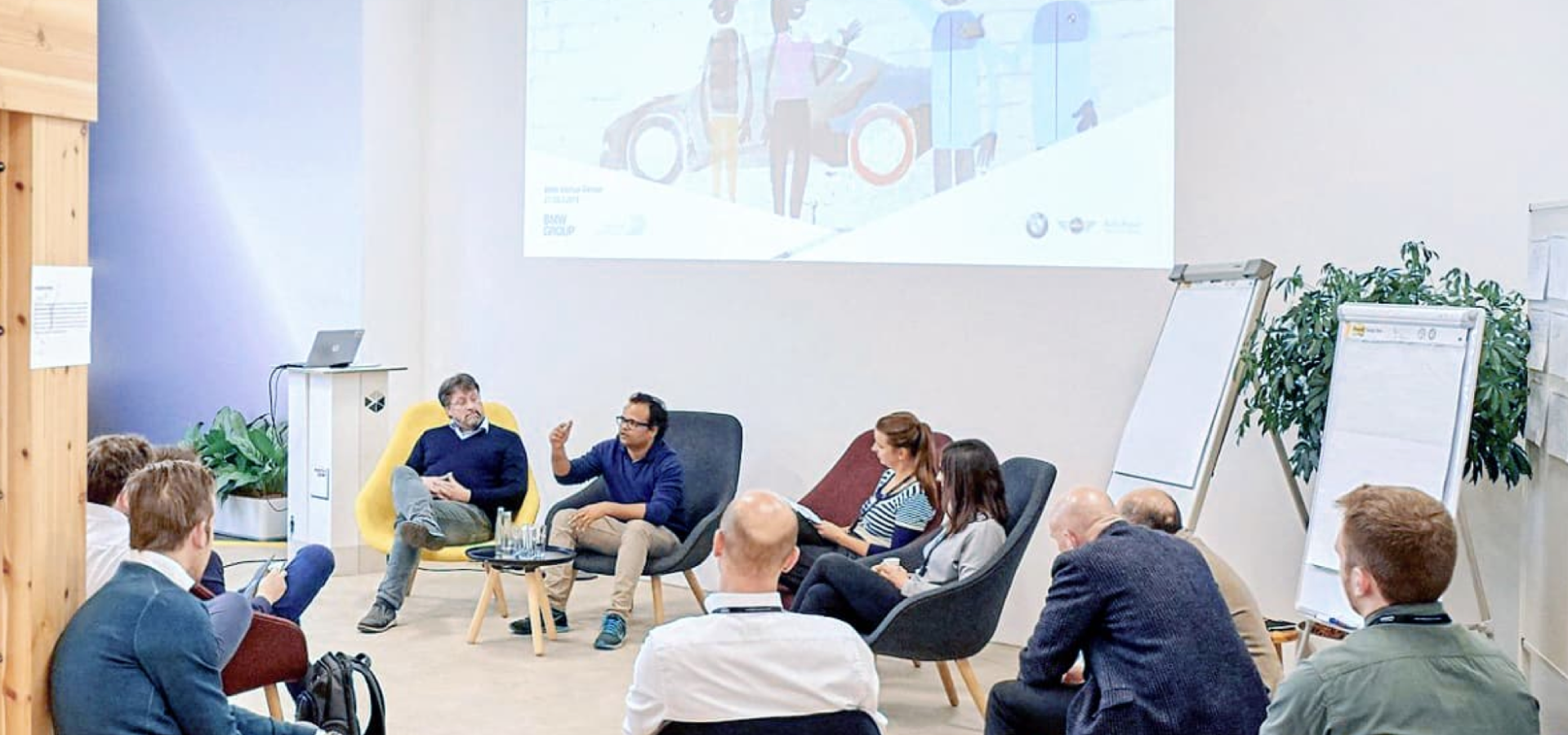Key takeaways
In today’s fast-moving corporate landscape, it’s no longer enough to build, buy, partner, or invest in just one isolated venture. The key to long-term success and cutting-edge innovation lies in spotting new growth areas fast and seizing emerging opportunities through a pipeline of new ventures. The approach enables you to constantly test, explore and experiment with new value propositions, technologies and business models, creating valuable revenue streams for the future.
So what’s the best way to boost your venture portfolio? Short answer: corporate venturing units.
Corporate venturing units enable companies to develop new ventures fast and strategically, spreading the risk (e.g.among multiple ventures) and increasing their probability of success. They work by enabling companies to effectively leverage existing corporate assets to launch multiple new offerings that:
- Test new products and services
- Explore new markets
- Grow beyond their core offering
In essence, building a more diversified portfolio ensures mature enterprises stay ahead of any disruptions to the market and can meet rapidly changing customer demands head-on. In addition, the learnings and insights gathered through each venture launched, will increase your company’s industry knowledge and entrepreneurial skills. This, in turn, will strengthen the chance of long-term success for years to come.
To give you a better idea of how corporate venture units work in practice, we’ve created a list of seven venture unit strategies you can use to boost your venture portfolio. We’ve even added some real-world examples that are sure to inspire you. Let’s get started!

Strategy 1. Venture Client Unit
Under the venture client model startups become innovation suppliers for corporates at a very early stage:
- Before the startup’s offering is mature or fully developed
- Before the startup has a proven business model
In essence, the corporation acts as an early adopter of the startup’s offering, nurturing its growth by becoming a customer. In some cases, the corporate can also provide valuable feedback about the new product or service, enabling the startup to make vital tweaks and iterations.
The products or services acquired from the startup are then used internally by the corporate in one of two ways:
- To improve the corporate's current offering
- To help create a new product or service
One of the biggest benefits of the venture client model is that it enables companies to test new solutions before making any big investments or commitments. This is because, as a venture client, the corporate has no equity stake in the startup. It also creates an opportunity for corporates to work closely with startups and test if there is a good fit before engaging in a long-term relationship.
Example: BMW Startup Garage
Founded: 2015
HQ: Munich, Germany
Industry: Automotive

Credited for creating the venture client model, BMW Startup Garage actively scouts the market for innovative solutions that create value for its parent company. Its M.O. consists of buying a first unit of the new startup’s technology and validate it using a 12-week program.
The value proposition is tested and improved during the program using BMW Group resources and in close collaboration with entrepreneurs as well as BMW engineers and managers. Validated solutions are then integrated with the BMW Group as a long-term client.
Examples of successful ventures from BMW Startup Garage include Seoul Robotics, Tactile Mobility and Embotech.

Strategy 2. Smart CVC
Smart Corporate Venture Capital (CVC) business units invest in companies (startups) not only to gain financial returns but also as a way to foster growth beyond the parent company’s core. This type of unit takes a strategic approach in which startups are chosen based on their potential to increase profits and market share through cutting-edge:
- Technologies
- Value propositions
- Business models
Startups that get chosen by a Smart CVC unit benefit from a variety of resources, including funding, mentoring, networks and access to a broader corporate ecosystem.
Example: Porsche Ventures
Founded: 2018
HQ: Stuttgart, Germany
Industry: Automotive

Porsche Ventures makes strategic investments in startups with the potential to help Porsche expand beyond the automotive industry into promising new growth segments, including (but not limited to):
- Mobility
- Artificial intelligence (AI)
- Blockchain
- Virtual reality (VR) and augmented reality (AR)
The unit specialises in working with early-stage startups, providing them not just with funding, but with incubation services as well.
Examples of successful investments by Porsche Ventures include Ridepanda, Rimac Automobili and Cresta.

Strategy 3. Ecosystem Facilitator
Ecosystem Facilitator units use multi-disciplinary knowledge hubs to foster open collaboration and bring new value propositions to the market. These hubs are made up of a variety of profiles, including entrepreneurs, partners from different industries and investors (among others).
The unit acts as a facilitator or “go-between” for corporates, startups and stakeholders, creating a strong ecosystem in which all members benefit. By combining knowledge and resources from all these different sources, ecosystem facilitator units effectively solve complex issues with innovative and out-of-the-box solutions.
Example: PlugandPlay
Founded: 2006
HQ: California, US
Industry: VC and private equity

PlugandPlay is the world’s largest startup accelerator, with over 2000 startups joining its programs in 2020 alone. The unit operates by enabling corporate partners to create sector-specific accelerators on demand. It connects relevant change-makers and leading organisations, enabling them to pool their resources and achieve their goals.
Its team is made up of experienced serial entrepreneurs, strategic investors, and industry leaders actively engaged in expanding PlugandPlay’s investment portfolio.
Examples of successful PlugandPlay ventures include Roche & Sorcero and PayPal.

Strategy 4. Funding-Driven Accelerator
Funding-driven accelerators provide startups with mentoring, business support, and funding. In addition, they facilitate connections with investors and business partners, helping startups scale their MVPs quicker.
Although funding-driven accelerator units support startups in a variety of ways, their main goal is to provide the capital needed to accelerate growth.
Example: Y Combinator (YC)
Founded: 2005
HQ: California, US
Industry: Software and web services
.png)
Twice a year, Y Combinator (YC) chooses a batch of promising startups, investing about $500K in each, in return for small stakes. Participating startups move to Silicon Valley for 3 months, where they work closely with the YC team to refine their value propositions and build expert investor pitches.
The program culminates in a DemoDay for each startup to pitch their company to an audience of investors. Examples of successful Y Combinator ventures include Stripe, Airbnb and Coinbase.

Strategy 5. Asset-Driven Accelerator
Asset-driven accelerator units provide startups with the usual training, funding and networking opportunities as well as additional benefits like:
- Company services
- Infrastructure
- Access to industry experts
- Access to the corporate’s customer base and data
In contrast to funding-driven accelerator units, the emphasis isn’t really on funding, but on providing access to valuable resources. The goal is to nurture startups through existing assets like infrastructure while adding new concepts and technologies to the corporate ecosystem.
Example: VRT Sandbox
Founded: 2014
HQ: Brussels, Belgium
Industry: Media

VRT Sandbox facilitates short-term collaborations between startups, SMEs and VRT. It serves as a matchmaker, linking the startup to a brand, and then, if it is the right match, the brand
staff and the startup work together.
Programs last three to four months, providing startups with the opportunity to test their innovations in the VRT environment, leveraging its infrastructure, production teams, and network. Although funding isn’t provided, startups do get access to expert coaching, international exposure and, sometimes, help forging new partnerships.
Examples of successful VRT Sandbox ventures include Playar.studio and Bothrs & ML6.

Strategy 6. Bespoke Venture Studio
The bespoke venture studios create and support ventures on a need basis, leveraging the expertise of experienced venture builders and the parent company’s corporate assets.
Venture studios are an effective way to support any type of innovation. Their broad expertise enables them to tackle various innovation challenges in various industries.
Example: Schenker Ventures

Specialised in logistics innovation, Schenker Venture Studio partners with entrepreneurs at the idea stage of their startup, enabling them to build it from scratch.
Within a period of two to three months, founders benefit from resources like DB Schenker’s industry expertise, network and MVP factory resources. Concepts with high potential are offered an investment of $300K in return of 23% equity, as well as continued launch and fundraising support.
Examples of their successful ventures include what3words and Volocopter.

Strategy 7. Hybrid Venturing Hub
Hybrid venturing hubs combine the assets of innovation tools like CVCs, accelerators, venture builders, etc. into one vehicle for growth. The approach is tailored on a case-by-case basis, ensuring it meets the needs and individual requirements of each venture (e.g. build, buy, partner, invest).
Its flexible approach enables you to pursue a variety of ventures, tackling different innovation levels from core to radical.
Example: LG NOVA

LG NOVA’s mission is to fuel innovation for LG and its partners by establishing a community to nurture, grow, and create businesses.
It helps companies validate their concepts by leveraging LG assets like their customer base, branding and network. Their flexible approach enables them to create joint ventures, invest or make complete acquisitions depending on their needs and interests.
Examples of their successful ventures include Kardome and Chefling.
The time to boost your venture portfolio is now.
Our corporate landscape is evolving at a head-spinning rate, driven by innovative new market entrants, shifting customer behaviour, and cutting-edge tech advances. Mature corporations have been the most affected, with companies like Hilton and Hertz exiting the Fortune 500 in favour of newer, tech-forward players like Paypal and Amazon.
Despite the rapid pace of change, companies like Walmart, Capital One, and BASF (just to name a few) have established their own corporate venture units, ensuring a pipeline of constant innovation and new revenue streams for years to come.
The strategies above can serve as a starting point to set up your own corporate venture unit and the best time to future-proof your business is now.
______
Are you interested in setting up your own corporate venturing unit? We can help you harness the power of your unique corporate assets to reach your growth goals and future-proof your business for years to come.
Discover the 7 venturing arm strategies
An analysis of the top corporate venturing portfolios









